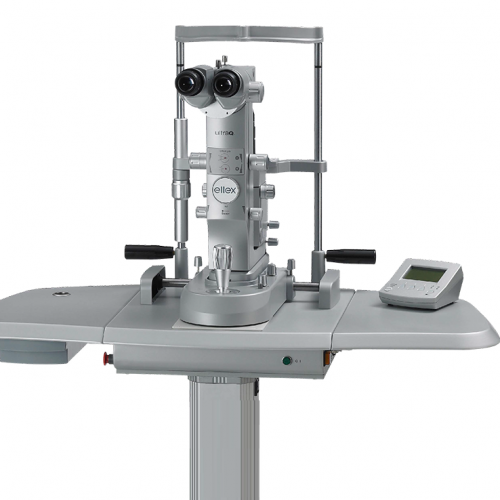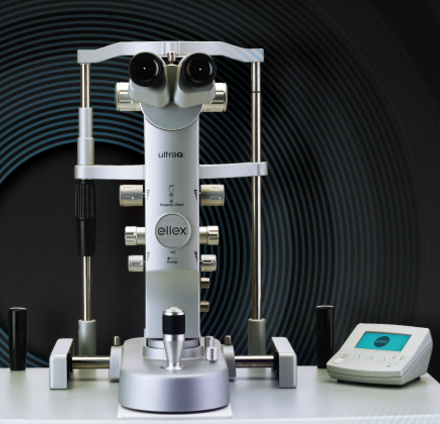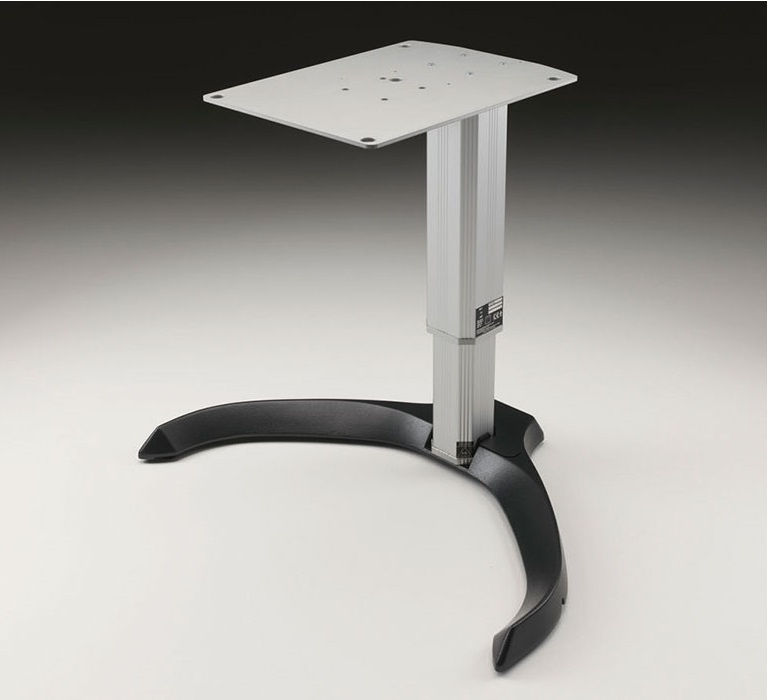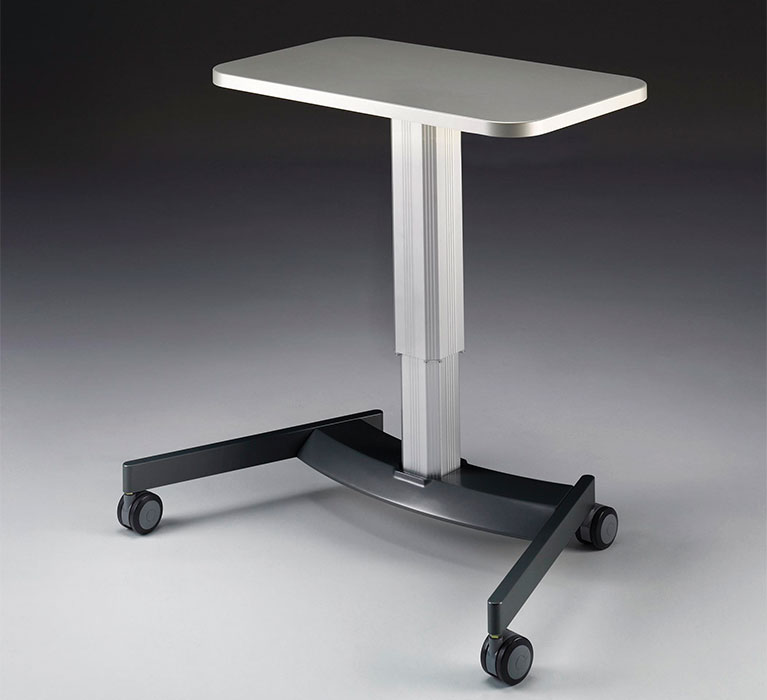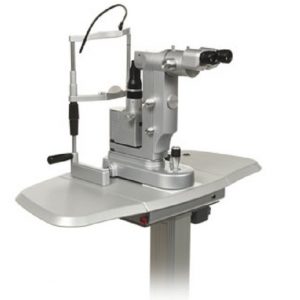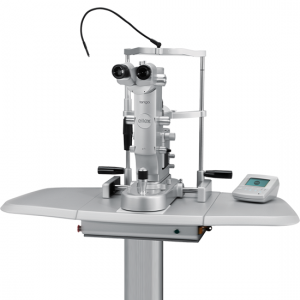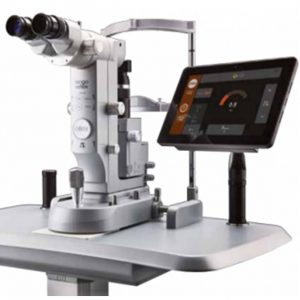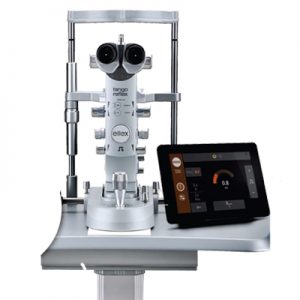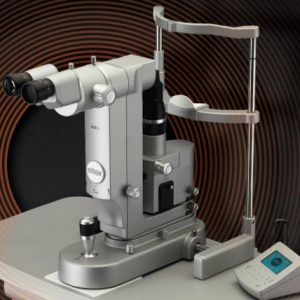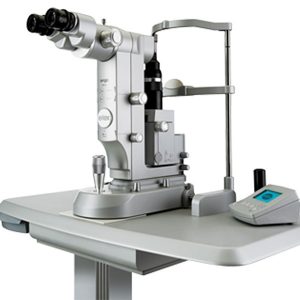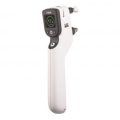1. Optimized Optics for Better Viewing
The quality and design of Ultra Q’s slit lamp optics are custom-designed for anterior YAG laser procedures. Featuring Galilean converging optics with a 16° stereoscopic angle, Ultra Q™ provides a more natural stereoscopic view combined with a small depth of field for precision focusing on structures in the anterior segment.
Unlike the standard glass components found in other YAG lasers, Ultra Q’s combination of high-grade crown glass materials and multi-layered, anti-reflection coatings on all optical components maximizes light transmission whilst minimizing dispersion to deliver better optical performance. In addition, next-generation filter technology provides the best color balance possible.
2. IOL-Friendly Photodisruption
Ultra Q™ allows you to cut tissue more effectively using fewer shots and less cumulative energy – dramatically reducing the risk of IOL pitting. Featuring an Ultra Gaussian beam profile, Ultra Q™ focuses more energy into the center of the beam profile to deliver greater energy density, achieving optical breakdown (in air) of approximately 1.8mJ, in optimal conditions. This compares to other YAG lasers, which typically achieve optical breakdown (in air) of 3 to 4mJ in optimal conditions.
Capsulotomy for Presbyopic IOLs
A precise capsulotomy is essential for IOLs that correct presbyopia through implantation in the posterior chamber’s capsular bag. Good IOL centration, in terms of the pupil, optimizes lens performance. In contrast, decentration can cause halos and poor vision. The goal is a perfectly centered, precise capsulotomy that will not affect the tension of the bag and the position of the IOL in the visual axis. The precision and ultra-low energy optical breakdown provided by the Ultra Q™ Reflex creates a capsulotomy opening that is precisely controlled, without causing damage to the lens – even if the lack of a ridge makes the capsule adhere to the optic.
Iridotomy for Phakic IOLs
Refractive IOLs that are designed to correct myopia, or hyperopia (also known as Phakic IOLs) can be placed in front of the iris or between the iris and the natural lens. To prevent any possibility of IOL-induced pupillary block, these lenses require peripheral iridotomies prior to surgery. The iridotomy aperture must be large enough to ensure a balanced aqueous flow, yet small enough so that no light is transmitted back to the pupil, which can cause double vision. The Ultra Q™ enables you to create a precise size of the iridotomy, often in a single shot that uses lower energy than other YAG lasers.
3. Accurately Position Optical Breakdown
Ultra Q’s continuously variable offset (from 100 to 500 microns) allows you to accurately set the distance between the focal plane and the position of the plasma ball – ensuring more effective and safer photodisruption. Depending on the treatment, the aiming beam focus can be placed exactly in front of, behind, or on the disruption laser focus.
In posterior capsulotomy, for example, the ideal placement of the plasma ball is slightly “posterior offset” from the target tissue to be incised, as the plasma ball creates shock waves that move back in the direction of the laser source (that is, towards the operator). This helps to ensure precise treatment whilst eliminating the risks of side effects such as IOL pitting.
4. Designed to Maximize Your Workflow
Ellex has integrated the laser and slit lamp for greater efficiency and reliability, as well as for improved ease of use. Ultra Q’s compact, efficient design provides you with additional working space – making it easier to align the patient and to position the contact lens. It also offers the added benefit of convenient, simultaneous access to the patient and laser controls.
5. Pinpoint Precision
With a tolerance range of ± 8 µm, Ultra Q’s two-point focusing system makes it easy for you to accurately position where the optical breakdown will take place, irrespective of whether you are working in the anterior segment or in the posterior segment.
With a two-point focusing system the two aiming beams converge in the focal plane. This simple, yet highly precise aiming system, is the most accurate at indicating when the laser and slit lamp view are in proper focus, as it allows you to see a separation of the two aiming beams (which indicates out-of-focus) with even the smallest of slit lamp (or patient) movements. In comparison, four-point and many other focusing systems require a significant shift in the slit lamp’s position before you can distinguish any separation of the aiming beams.
6. Better Performance Over the Long-Term
A Q-switch is an optical component used to “gate” energy in order to generate a short, high peak-energy pulse The Q-switching element used in Ultra Q™ is fabricated from highly stable, homogenous materials, which exhibit similar expansion characteristics. Unlike organic polymer materials that can cause inconsistent treatment performance due to material warping and fatigue, the materials used in the Ultra Q™ Q-Switch are thermally matched to deliver more consistent performance over a number of different operating conditions – ensuring robust, reliable performance and a lifespan of more than 400,000 shots.
In addition, Ultra Q’s custom-built YAG power supply incorporates a micro-controller and energy compensation algorithm to deliver greater shot-to-shot consistency. Many other YAG lasers use a commercial, off-the-shelf YAG power supply.
7. Faster Treatment
With a fast firing rate of up to 3 shots per second (3 Hertz), Ultra Q™ saves you time and allows you to perform quick and highly accurate treatment. Ultra Q’s patented, proprietary cavity facilitates more effective heat transfer and cooling, thereby permitting fast, efficient operation. In addition, the system’s pulse capacitors are rapidly recharged between each and every shot without the risk of overheating – ensuring you of uninterrupted operation.
8. Configured to Meet Your Needs
Configured to meet your needs, Ultra Q™ can be combined with the Total Solution™ table range in order to meet the needs of ophthalmic offices, ambulatory surgery centers and hospital outpatient clinics.
 Considered to be the industry’s leading microsurgical YAG laser, Ultra Q™ features a patented, proprietary cavity and a custom power supply, which allow you to perform capsulotomy and iridotomy procedures at lower, more efficient power levels and with greater shot-to-shot consistency. It is also the world’s fastest YAG laser, with a firing rate of 3 shots per second.
Considered to be the industry’s leading microsurgical YAG laser, Ultra Q™ features a patented, proprietary cavity and a custom power supply, which allow you to perform capsulotomy and iridotomy procedures at lower, more efficient power levels and with greater shot-to-shot consistency. It is also the world’s fastest YAG laser, with a firing rate of 3 shots per second.
